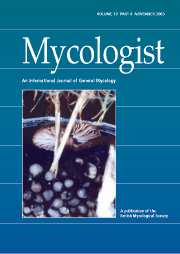Article contents
Bees and phalloid exudate
Published online by Cambridge University Press: 16 September 2002
Abstract
Early in the nineteenth century John Curtis (1833) investigated flies attracted to a phalloid fructification in England. The fungus was found in some abundance on “the sand-hills near Lowestoft, Suffolk, in the middle of October”. It had a scent like violets at a distance, in the field, but was very offensive when dried. Curtis stated that it seemed “to differ materially from the Phallus foetidus Lam. (P. impudicus Linn.)”. Flies of all descriptions were much attached to the fungus and, as well as bees and beetles, seemed very fond of the “shining matter which dropped from the pileus”. The bees were not identified. A pale pinkish flush over the volva was visible in the original illustration. The fungus seems to represent Phallus hadriani Vent. (syn. P. iosmus Berk.) the basal volva of which becomes pinkish to reddish when exposed. It is also said to smell sweeter than P. impudicus, often of violets. It is the less common of the two Phallus species in Britain, being more or less restricted to coastal dunes (Pegler et al., 1995).
Keywords
Information
- Type
- Original Article
- Information
- Copyright
- © 2002 Cambridge University Press
- 1
- Cited by

